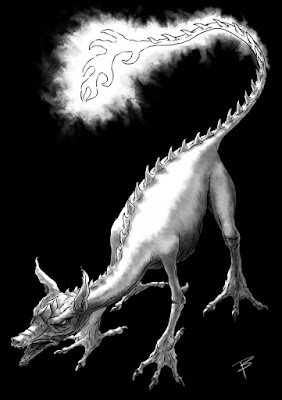FROST SNAIL
FREQUENCY: Very rareNO. APPEARING: 1
ARMOR CLASS: 4
MOVE: 4"
HIT DICE: 6-8
% IN LAIR: Nil
TREASURE TYPE: Nil
NO. OF ATTACKS: 1 per tentacle
DAMAGE/ATTACK: See below
SPECIAL ATTACKS: See below
SPECIAL DEFENSES: None
MAGIC RESISTANCE: Standard
INTELLIGENCE: Low
ALIGNMENT: Neutral
SIZE: L
PSIONIC ABILITY: Nil
Attack/Defense Modes: Nil
Frost Snails appear to be a larger (12 feet long, 10 feet tall) relative of the Flail Snail and Flame Snail. They will be encountered within ice caves or similarly cold places and will never venture into temperate zones unless they experience intense winter conditions.
It has one tentacle for every 2 hit dice that it
possesses. Every second tentacle will have the ability to cast a Cone of Cold as an 8th level Magic-User, while the rest can each fire a large, needle-like dart of ice out to a range of 5". Each dart inflicts 2-12 points of damage.
Frost Snails
are not known for their speed, but should any victim
fall beneath it they will receive 1-6 points of damage per turn by being
crushed by the snail's weight. Cold-based attacks, magical or mundane, will have no effect upon it and
will simply allow the snail to regain 1 HD of hit points per attack,
should it have lost any previously. Heat and flame-based attacks affect it normally.
If the snail has a violent death its shell will quickly begin to disintegrate (in 1d4+1 rounds) and will radiate an intensely cold cloud of mist out to 3" in all directions. Any creature caught within this mist will suffer 2-12 points of damage unless a saving throw versus dragon breath is made, in which case the damage is halved. However, if a Cone of Cold is cast upon the shell, this will halt the melting process.
Intact
shells are very rare and usually only found when a Frost Snail has died
naturally, or unless the aforementioned circumstances have occurred in a very timely fashion. The shell weighs 500 pounds (5000 gold pieces weight) and
can be fashioned into items that are completely resistant to cold, magical or mundane. Larger icicle-like projections that cover the shell can be fashioned into weapons of +1 to +3, if a skilled artificer can be found. A complete shell is worth 10,000 gold
pieces - partially melted examples have this value reduced by 2000 gold pieces per round they have melted before a preservative Cone of Cold was cast.
Description: Frost Snails are a scintillating blue-white in colour. The shell appears to be highly polished, glass-like ice while its body and tentacles are semi-opaque and glisten with a layer of frost.


















